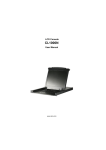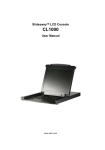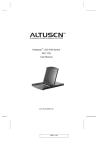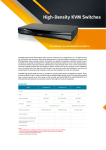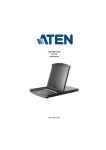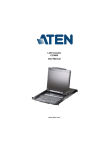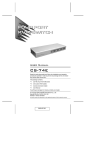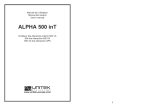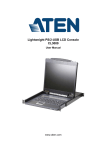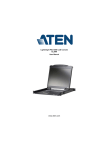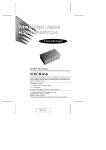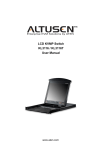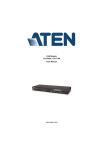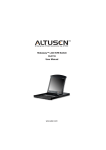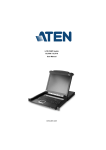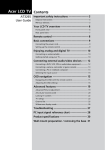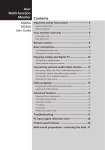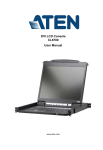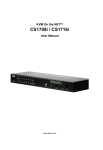Download LCD Console CL1000N User Manual
Transcript
LCD Console CL1000N User Manual www.aten.com CL1000N User Manual EMC Information FEDERAL COMMUNICATIONS COMMISSION INTERFERENCE STATEMENT: This equipment has been tested and found to comply with the limits for a Class A digital device, pursuant to Part 15 of the FCC Rules. These limits are designed to provide reasonable protection against harmful interference when the equipment is operated in a commercial environment. This equipment generates, uses, and can radiate radio frequency energy and, if not installed and used in accordance with the instruction manual, may cause harmful interference to radio communications. Operation of this equipment in a residential area is likely to cause harmful interference in which case the user will be required to correct the interference at their own expense. FCC Caution: Any changes or modifications not expressly approved by the party responsible for compliance could void the user’s authority to operate this equipment. CE Warning: This is a class A product. In a domestic environment this product may cause radio interference in which case the user may be required to take adequate measures. This device complies with Part 15 of the FCC Rules. Operation is subject to the following two conditions: (1) this device may not cause harmful interference, and (2) this device must accept any interference received, including interference that may cause undesired operation. KCC Statement 유선 제품용 / A 급 기기 ( 업무용 방송 통신 기기 ) 이 기기는 업무용 (A 급 ) 전자파적합기기로서 판매자 또는 사용자는 이 점을 주의하시기 바라며 , 가정 외의 지역에서 사용하는 것을 목적으로 합니다 . RoHS This product is RoHS compliant. ii CL1000N User Manual SJ/T 11364-2006 The following contains information that relates to China. iii CL1000N User Manual User Information Online Registration Be sure to register your product at our online support center: International http://eservice.aten.com Telephone Support For telephone support, call this number: International 886-2-8692-6959 China 86-10-5255-0110 Japan 81-3-5615-5811 Korea 82-2-467-6789 North America 1-888-999-ATEN ext 4988 United Kingdom 44-8-4481-58923 iv CL1000N User Manual User Notice All information, documentation, and specifications contained in this manual are subject to change without prior notification by the manufacturer. The manufacturer makes no representations or warranties, either expressed or implied, with respect to the contents hereof and specifically disclaims any warranties as to merchantability or fitness for any particular purpose. Any of the manufacturer's software described in this manual is sold or licensed as is. Should the programs prove defective following their purchase, the buyer (and not the manufacturer, its distributor, or its dealer), assumes the entire cost of all necessary servicing, repair and any incidental or consequential damages resulting from any defect in the software. The manufacturer of this system is not responsible for any radio and/or TV interference caused by unauthorized modifications to this device. It is the responsibility of the user to correct such interference. The manufacturer is not responsible for any damage incurred in the operation of this system if the correct operational voltage setting was not selected prior to operation. PLEASE VERIFY THAT THE VOLTAGE SETTING IS CORRECT BEFORE USE. A typical LCD (Liquid Crystal Display) monitor has millions of pixels. A dead pixel refers to a pixel with a defect in its ability to display the correct color output. It most often looks like a tiny black or white spot on your screen, although it can be any other color. Since even a tiny dust particle on one of the pixels during the manufacturing process or a slight bump during shipping can create a dead pixel, the ISO 13406-2 norm defines 4 classes of acceptable screens with dead pixels--Class 1 is the best; Class 4 is the worst. Almost all manufacturers use Class 2 to establish their warranties, which allows a certain amount of dead pixels to exist before they will replace the screen. Since the manufacturers consider these screens to be acceptable under ISO specifications, we cannot be responsible for replacement or warranty of the TFT LCD panel. v CL1000N User Manual Package Contents Basic Package The basic CL1000N package consists of: 1 CL1000N with Standard Rack Mount Kit 1 Custom KVM Cable Set 1 Power Cord 1 User Instructions* Optional Equipment Depending on any optional equipment that you may have purchased, one of the following may be included in your package: Standard Rack Mount Kit - Long Easy-Installation Rack Mount Kit - Short Easy-Installation Rack Mount Kit - Long Check to make sure that all the components are present and that nothing got damaged in shipping. If you encounter a problem, contact your dealer. Read this manual thoroughly and follow the installation and operation procedures carefully to prevent any damage to the unit, and/or any of the devices connected to it. * Features may have been added to the CL1000N since this manual was published. Please visit our website to download the most up-to-date version. © Copyright 2015 ATEN® International Co., Ltd. Manual Date: 2015-04-24 ATEN and the ATEN logo are registered trademarks of ATEN International Co., Ltd. All rights reserved. All other brand names and trademarks are the registered property of their respective owners. vi CL1000N User Manual Contents EMC Information . . . . . . . . . . . . . . . . . . . . . . . . . . . . . . . . . . . . . . . . . . . . . ii RoHS. . . . . . . . . . . . . . . . . . . . . . . . . . . . . . . . . . . . . . . . . . . . . . . . . . . . . . ii SJ/T 11364-2006. . . . . . . . . . . . . . . . . . . . . . . . . . . . . . . . . . . . . . . . . . . . .iii User Information . . . . . . . . . . . . . . . . . . . . . . . . . . . . . . . . . . . . . . . . . . . . iv Online Registration . . . . . . . . . . . . . . . . . . . . . . . . . . . . . . . . . . . . . . . iv Telephone Support . . . . . . . . . . . . . . . . . . . . . . . . . . . . . . . . . . . . . . . iv User Notice . . . . . . . . . . . . . . . . . . . . . . . . . . . . . . . . . . . . . . . . . . . . . . v Package Contents. . . . . . . . . . . . . . . . . . . . . . . . . . . . . . . . . . . . . . . . . . . vi Basic Package. . . . . . . . . . . . . . . . . . . . . . . . . . . . . . . . . . . . . . . . . . . vi Optional Equipment . . . . . . . . . . . . . . . . . . . . . . . . . . . . . . . . . . . . . . . vi About this Manual . . . . . . . . . . . . . . . . . . . . . . . . . . . . . . . . . . . . . . . . . . . ix Conventions . . . . . . . . . . . . . . . . . . . . . . . . . . . . . . . . . . . . . . . . . . . . . . . . x Product Information. . . . . . . . . . . . . . . . . . . . . . . . . . . . . . . . . . . . . . . . . . . x 1. Introduction Overview . . . . . . . . . . . . . . . . . . . . . . . . . . . . . . . . . . . . . . . . . . . . . . . . . . . 1 Features . . . . . . . . . . . . . . . . . . . . . . . . . . . . . . . . . . . . . . . . . . . . . . . . . . . 2 Requirements . . . . . . . . . . . . . . . . . . . . . . . . . . . . . . . . . . . . . . . . . . . . . . . 3 Switches and Computers . . . . . . . . . . . . . . . . . . . . . . . . . . . . . . . . . . . 3 Cables . . . . . . . . . . . . . . . . . . . . . . . . . . . . . . . . . . . . . . . . . . . . . . . . . . 3 Operating Systems . . . . . . . . . . . . . . . . . . . . . . . . . . . . . . . . . . . . . . . . 3 Components . . . . . . . . . . . . . . . . . . . . . . . . . . . . . . . . . . . . . . . . . . . . . . . . 4 Front View . . . . . . . . . . . . . . . . . . . . . . . . . . . . . . . . . . . . . . . . . . . . . . . 4 Rear View . . . . . . . . . . . . . . . . . . . . . . . . . . . . . . . . . . . . . . . . . . . . . . . 5 2. Hardware Setup Before you Begin . . . . . . . . . . . . . . . . . . . . . . . . . . . . . . . . . . . . . . . . . . . . 7 Standard Rack Mounting. . . . . . . . . . . . . . . . . . . . . . . . . . . . . . . . . . . . . . . 7 Installation . . . . . . . . . . . . . . . . . . . . . . . . . . . . . . . . . . . . . . . . . . . . . . . . . . 9 3. Operation Opening the Console . . . . . . . . . . . . . . . . . . . . . . . . . . . . . . . . . . . . . . . . 11 Closing the Console . . . . . . . . . . . . . . . . . . . . . . . . . . . . . . . . . . . . . . . . . 13 Operating Precautions . . . . . . . . . . . . . . . . . . . . . . . . . . . . . . . . . . . . . . . 14 LCD OSD Configuration . . . . . . . . . . . . . . . . . . . . . . . . . . . . . . . . . . . . . . 15 The LCD Buttons . . . . . . . . . . . . . . . . . . . . . . . . . . . . . . . . . . . . . . . . . 15 The Adjustment Settings . . . . . . . . . . . . . . . . . . . . . . . . . . . . . . . . . . . 15 Port ID Numbering & Port Selection . . . . . . . . . . . . . . . . . . . . . . . . . . . . . 16 Appendix Safety Instructions. . . . . . . . . . . . . . . . . . . . . . . . . . . . . . . . . . . . . . . . . . . 17 General . . . . . . . . . . . . . . . . . . . . . . . . . . . . . . . . . . . . . . . . . . . . . . . . 17 Rack Mounting . . . . . . . . . . . . . . . . . . . . . . . . . . . . . . . . . . . . . . . . . . 19 Consignes de sécurité. . . . . . . . . . . . . . . . . . . . . . . . . . . . . . . . . . . . . . . . 20 vii CL1000N User Manual Général . . . . . . . . . . . . . . . . . . . . . . . . . . . . . . . . . . . . . . . . . . . . . . . . 20 Montage sur bâti . . . . . . . . . . . . . . . . . . . . . . . . . . . . . . . . . . . . . . . . . 23 Technical Support. . . . . . . . . . . . . . . . . . . . . . . . . . . . . . . . . . . . . . . . . . . 24 International . . . . . . . . . . . . . . . . . . . . . . . . . . . . . . . . . . . . . . . . . . . . 24 North America . . . . . . . . . . . . . . . . . . . . . . . . . . . . . . . . . . . . . . . . . . . 24 Specifications . . . . . . . . . . . . . . . . . . . . . . . . . . . . . . . . . . . . . . . . . . . . . . 25 Optional Rack Mounting . . . . . . . . . . . . . . . . . . . . . . . . . . . . . . . . . . . . . . 26 About SPHD Connectors . . . . . . . . . . . . . . . . . . . . . . . . . . . . . . . . . . . . . 29 Limited Warranty. . . . . . . . . . . . . . . . . . . . . . . . . . . . . . . . . . . . . . . . . . . . 30 viii CL1000N User Manual About this Manual This User Manual is provided to help you get the most from your CL1000N system. It covers all aspects of installation, configuration and operation. An overview of the information found in the manual is provided below. Chapter 1, Introduction, introduces you to the CL1000N system. Its purpose, features and benefits are presented, and its front and back panel components are described. Chapter 2, Hardware Setup, provides step-by-step instructions for setting up your installation, and explains some basic operation procedures. Chapter 3, Operation, explains the fundamental concepts involved in operating the CL1000N. An Appendix, provides specifications and other technical information regarding the CL1000N. ix CL1000N User Manual Conventions This manual uses the following conventions: Monospaced [] Indicates text that you should key in. Indicates keys you should press. For example, [Enter] means to press the Enter key. If keys need to be chorded, they appear together in the same bracket with a plus sign between them: [Ctrl+Alt]. 1. Numbered lists represent procedures with sequential steps. ♦ Bullet lists provide information, but do not involve sequential steps. → Indicates selecting the option (on a menu or dialog box, for example), that comes next. For example, Start → Run means to open the Start menu, and then select Run. Indicates critical information. Product Information For information about all ATEN products and how they can help you connect without limits, visit ATEN on the Web or contact an ATEN Authorized Reseller. Visit ATEN on the Web for a list of locations and telephone numbers: International http://www.aten.com North America http://www.aten-usa.com x Chapter 1 Introduction Overview The CL1000N is a LCD KVM console that features an integrated 19” LEDbacklit LCD panel, full keyboard, and touchpad in a 1U rack-mountable sliding housing. This model provides convenient ‘at the rack’ console access to KVM switches already installed at your site. It was developed in response to the enormous popularity of the sliding console found on the CL1008 and CL1016 KVM switches. Those switches are made up of two major modules: the front-end sliding KVM Console module, and the back-end KVM Switch module. The CL1000N is similar to the front-end Console module found on the CL1008 and CL1016. Its purpose is to serve as the front end sliding console for compatible KVM switches. By only having to purchase the CL1000N, users who already have a compatible KVM switch can take advantage of the space saving and efficiency benefits of the sliding console module without the unnecessary expense of having to purchase a model that includes a KVM switch module. Setup is fast and easy. Simply use the KVM cable set supplied with this package to link the CL1000N's KVM port to the console port of your KVM switch and you are ready to go. 1 CL1000N User Manual Features Exclusive LED illumination light - designed by ATEN to illuminate the keyboard and touchpad to allow visibility in low-light conditions Integrated KVM console with a 19" LED-backlit LCD monitor in a sliding housing with top and bottom clearance for smooth operation in a 1U high system rack LCD module rotates up to 115o for a more comfortable viewing angle Standard rack mount kit included – optional Easy Rack Mounting (single person installation) rack mount kit available (requires separate purchase) Compatible with most KVM switches Internal power supply High video resolution: Up to 1280 x 1024 @75Hz Supports DDC, DDC2, DDC2B DDC emulation of the LCD monitor Video settings of attached computers are automatically adjusted for optimal output to the LCD monitor Keyboard languages supported English (UK), English (US), French, German, German (Swiss), Greek, Hungarian, Italian, Japanese, Korean, Russian, Spanish, Swedish, and Traditional Chinese 2 Chapter 1. Introduction Requirements Switches and Computers The CL1000N supports most KVM switches that have PS/2 console port connectors. If you are unsure whether your switch is supported or not, check with your dealer. The integrated LCD monitor's maximum resolution is 1280 x 1024 @ 75 Hz. Make sure that none of the resolution settings of the connected computers exceed the LCD monitor's maximum resolution. Cables For optimum signal integrity and to simplify the layout, we strongly recommend that you use the high quality custom cable set provided with this package. Different length cable sets, described in the table below, can be purchased from your dealer. Function KVM switch to computer Length Part Number PS/2 1.2 m 1.8 m 1.8 m 3.0 m 6.0 m 2L-5201P 2L-5202P 2L-5702P 2L-5203P 2L-5206P USB 1.8 m 3.0 m 5.0 m 6.0 m 2L-5202UP 2L-5203UP 2L-5205UP 2L-5206UP Operating Systems Supported operating systems are shown in the table, below: OS Version Windows Linux 2000 and higher RedHat 7.1–7.3, 8.0, 9.0, Fedora Core 2–4 SuSE Mandriva (Mandrake) UNIX Novell 8.2, 9.3, 10 9, 2005 Limited Edition, 2006 AIX 4.3, 5L FreeBSD 4.2, 4.5 Netware 5.0*, 6.0 * This operating system does not support USB. 3 CL1000N User Manual Components Front View No. Component 4 Description 1 Handle Pull to slide the KVM module out; push to slide the module in. 2 Slide Release In order to slide the console out, you must first release it by moving this tab sideways. See page 11 for details on sliding the console in and out. 3 LCD Display After sliding the KVM module out, flip up the cover to access the 19” LCD monitor. 4 LCD Controls The LCD On/Off switch is located here, as well as buttons to control the position and picture settings of the LCD display. See page 15, for details. 5 Keyboard Standard 105-key Keyboard. 6 Touchpad Standard Touch Pad. Chapter 1. Introduction 7 CPU LED Lights green to indicate that the unit is connected to the KVM Switch port. 8 Rack Mounting Brackets The rack mounting brackets located at each corner of the unit secure the chassis to a system rack. 9 Lock LEDs The Num Lock, Caps Lock, Scroll Lock LEDs are located here. 10 LCD On / Off Button Push this button to turn the LCD monitor on and off. The button lights when the LCD monitor is off. Note: The light indicates that only the monitor is off, not the attached KVM switch. 11 LED Illumination Light Press the Exit/Light pushbutton for two seconds to turn the LED light ON or Off. (Default: On) Rear View 1 2 No. Component Description 1 Power Socket This is a standard 3-prong AC power socket. The power cord from your AC source plugs in here. 2 KVM Port The cable that links the CL1000N to the KVM switch plugs in here. Note: The shape of this SPHD connector has been specifically modified so that only KVM cables designed to work with this switch can plug in (see Cables, page 3, for details). 5 CL1000N User Manual This Page Intentionally Left Blank 6 Chapter 2 Hardware Setup Before you Begin 1. Important safety information regarding the placement of this device is provided on page 17. Please review it before proceeding. 2. Make sure that power to all the devices you will be connecting up have been turned off. You must unplug the power cords of any computers that have the Keyboard Power On function. Standard Rack Mounting A standard rack mount kit is provided with your CL1000N. The kit enables the console to be mounted in rack with a depth of 52–85 cm. L Brackets Side Mountng Brackets Note: 1. It takes two people to mount the console: one to hold it in place, the other to screw it in. 2. The standard rack mounting kit does not include screws or cage nuts. If you need additional screws or cage nuts, contact your rack dealer. 3. Optional mounting kits, including single person Easy Installation kits, are available with a separate purchase. See page 26 for optional rack mounting details. 7 CL1000N User Manual To rack mount the console, do the following: 1. While one person positions the CL1000N in the rack and holds it in place, the second person loosely screws the front brackets to the rack. 2. While the first person still holds the CL1000N in place, the second person slides the L brackets into the CL1000N's side mounting brackets from the rear until the bracket flanges contact the rack, then screws the L brackets to the rack. 3. After the L brackets have been secured, tighten the front bracket screws. Note: Allow at least 5.1 cm on each side for proper ventilation, and at least 12.7 cm at the back for the power cord and cable clearance. 8 Chapter 2. Hardware Setup Installation Refer to the installation diagram as you perform the installation steps. The numbers in the diagrams correspond to the numbers of the steps. 1. Plug the SPHD connector end of the KVM cable provided with this unit into the CL1000N's KVM port. 2. Plug the keyboard, monitor, and mouse connectors of the KVM cable provided with this unit, into the 5 in 1 console cable that connects to the console section of the KVM switch. Note: Supports PS/2 or USB KVM switches Supports computers with PS/2 or USB keyboard and mice 3. Plug the power cord into the CL1000N's power socket and into an AC power source to power up your KVM LCD console. 4. Power up your KVM installation. 3 1 e.g., CS1716A 4 2 9 CL1000N User Manual This Page Intentionally Left Blank 10 Chapter 3 Operation Opening the Console The CL1000N's console is located under the top cover. To access the console, slide the console module out and raise the cover. Note: As a safety precaution, to keep the console from accidentally sliding out, the console is locked into the In position. Before you can pull the console module out, you must release it by pushing the catches on the unit's front panel as indicated below. To slide the console module out, do the following: 1. Push the catches inward. 11 CL1000N User Manual 2. Slide the module all the way out until it automatically locks in place. 3. Open the cover. 12 Chapter 3. Operation Closing the Console To slide the console module back in, do the following: 1. Close the cover. 2. Push the module all the way in. 13 CL1000N User Manual Operating Precautions The maximum load bearing capacity of the keyboard module is 30 kg. Failure to heed the information below can result in damage to the keyboard module. Right! Rest your hands and arms lightly on the keyboard module as you work. Wrong! DO NOT lean your body weight on the keyboard module. DO NOT place heavy objects on the keyboard module. 14 Chapter 3. Operation LCD OSD Configuration The LCD Buttons The LCD OSD allows you to set up and configure the LCD display. Four buttons are used to perform the configuration, as described in the table, below: Button MENU Function When you have not entered the LCD OSD Menu function, pressing this button invokes the Menu function, and brings up the Main Menu. When you have entered the LCD OSD Menu function, and have reached a setting choice with the navigation buttons, pressing this button brings up its adjustment screen. When navigating through the menus, this button moves you Right or Up. When making an adjustment, it increases the value. When navigating through the menus, this button moves you Left or Down. When making an adjustment, it decreases the value. EXIT When you have not entered the LCD OSD Menu function, pressing this button performs an auto adjustment. An auto adjustment automatically configures all the settings for the LCD panel to what the OSD considers their optimum values to be. When you have entered the LCD OSD Menu function, pressing this button exits the current menu and returns you to the previous menu. Use it to leave an adjustment menu when you are satisfied with the adjustment you made. When you are at the Main Menu, pressing this button exits the LCD OSD. The Adjustment Settings An explanation of the LCD OSD adjustment settings is given in the table below: Setting Explanation Brightness Adjusts the background black level of the screen image. Contrast Adjusts the foreground white level of the screen image. Phase If pixel jitter or horizontal line noise is visible on the display, your LCD may have the wrong phase setting. Adjust the phase setting to eliminate these problems. Clock If vertical banding is visible on the display, your LCD may have the wrong clock setting. Adjust the clock setting to eliminate vertical banding. H-Position Positions the display area on the LCD panel horizontally (moves the display area left or right). 15 CL1000N User Manual Setting Explanation V-Position Positions the display area on the LCD panel vertically (moves the display area up or down). Color Temperature Adjusts the color quality of the display. You can adjust the warmth value, color balance, etc. The Adjust Color selection has a further submenu that lets you fine tune the RGB values. Language Selects the language that the OSD displays its menus in. OSD Duration Lets you set the amount of time the OSD displays on the screen. If there is no input for the amount of time you choose, the OSD display turns off. Reset Resets the adjustments on all menus and submenus to their factory default settings. Note: The Language setting does not return to the factory default, but remains at the one that you have set it to. Port ID Numbering & Port Selection Port ID numbering and Port Selection follow the method used by the KVM switch connected to the CL1000N. Consult your KVM switch's User Manual for details. 16 Appendix Safety Instructions General This product is for indoor use only. Read all of these instructions. Save them for future reference. Follow all warnings and instructions marked on the device. To prevent damage to your installation it is important that all devices are properly grounded. Do not place the device on any unstable surface (cart, stand, table, etc.). If the device falls, serious damage will result. Do not use the device near water. Do not place the device near, or over, radiators or heat registers. The device cabinet is provided with slots and openings to allow for adequate ventilation. To ensure reliable operation, and to protect against overheating, these openings must never be blocked or covered. The device should never be placed on a soft surface (bed, sofa, rug, etc.) as this will block its ventilation openings. Likewise, the device should not be placed in a built in enclosure unless adequate ventilation has been provided. Never spill liquid of any kind on the device. Unplug the device from the wall outlet before cleaning. Do not use liquid or aerosol cleaners. Use a damp cloth for cleaning. The device should be operated from the type of power source indicated on the marking label. If you are not sure of the type of power available, consult your dealer or local power company. The device is designed for IT power distribution systems with 230V phase-to-phase voltage. The device is equipped with a 3-wire grounding type plug. This is a safety feature. If you are unable to insert the plug into the outlet, contact your electrician to replace your obsolete outlet. Do not attempt to defeat the purpose of the grounding-type plug. Always follow your local/national wiring codes. Do not allow anything to rest on the power cord or cables. Route the power cord and cables so that they cannot be stepped on or tripped over. 17 CL1000N User Manual If an extension cord is used with this device make sure that the total of the ampere ratings of all products used on this cord does not exceed the extension cord ampere rating. Make sure that the total of all products plugged into the wall outlet does not exceed 15 amperes. To help protect your system from sudden, transient increases and decreases in electrical power, use a surge suppressor, line conditioner, or un-interruptible power supply (UPS). Position system cables and power cables carefully; Be sure that nothing rests on any cables. Never push objects of any kind into or through cabinet slots. They may touch dangerous voltage points or short out parts resulting in a risk of fire or electrical shock. Do not attempt to service the device yourself. Refer all servicing to qualified service personnel. If the following conditions occur, unplug the device from the wall outlet and bring it to qualified service personnel for repair. The power cord or plug has become damaged or frayed. Liquid has been spilled into the device. The device has been exposed to rain or water. The device has been dropped, or the cabinet has been damaged. The device exhibits a distinct change in performance, indicating a need for service. The device does not operate normally when the operating instructions are followed. Only adjust those controls that are covered in the operating instructions. Improper adjustment of other controls may result in damage that will require extensive work by a qualified technician to repair. Do not connect the RJ-11 connector marked “UPGRADE” to a public telecommunication network. 18 Appendix Rack Mounting Before working on the rack, make sure that the stabilizers are secured to the rack, extended to the floor, and that the full weight of the rack rests on the floor. Install front and side stabilizers on a single rack or front stabilizers for joined multiple racks before working on the rack. Always load the rack from the bottom up, and load the heaviest item in the rack first. Make sure that the rack is level and stable before extending a device from the rack. Use caution when pressing the device rail release latches and sliding a device into or out of a rack; the slide rails can pinch your fingers. After a device is inserted into the rack, carefully extend the rail into a locking position, and then slide the device into the rack. Do not overload the AC supply branch circuit that provides power to the rack. The total rack load should not exceed 80 percent of the branch circuit rating. Make sure that all equipment used on the rack – including power strips and other electrical connectors – is properly grounded. Ensure that proper airflow is provided to devices in the rack. Ensure that the operating ambient temperature of the rack environment does not exceed the maximum ambient temperature specified for the equipment by the manufacturer Do not step on or stand on any device when servicing other devices in a rack. Caution: Slide/rail (LCD KVM) mounted equipment is not to be used as a shelf or a work space. 19 CL1000N User Manual Consignes de sécurité Général Ce produit est destiné exclusivement à une utilisation à l’intérieur. Veuillez lire la totalité de ces instructions. Conservez-les afin de pouvoir vous y référer ultérieurement. Respectez l’ensemble des avertissements et instructions inscrits sur l’appareil. Ne placez jamais l’unité sur une surface instable (chariot, pied, table, etc.). Si l’unité venait à tomber, elle serait gravement endommagée. N’utilisez pas l’unité à proximité de l’eau. Ne placez pas l’unité à proximité de ou sur des radiateurs ou bouches de chaleur. Le boîtier de l’unité est doté de fentes et d’ouvertures destinées à assurer une ventilation adéquate. Pour garantir un fonctionnement fiable et protéger l’unité contre les surchauffes, ces ouvertures ne doivent jamais être bloquées ou couvertes. L’unité ne doit jamais être placée sur une surface molle (lit, canapé, tapis, etc.) car ses ouvertures de ventilation se trouveraient bloquées. De même, l’unité ne doit pas être placée dans un meuble fermé à moins qu'une ventilation adaptée ne soit assurée. Ne renversez jamais de liquides de quelque sorte que ce soit sur l’unité. Débranchez l’unité de la prise murale avant de la nettoyer. N’utilisez pas de produits de nettoyage liquide ou sous forme d’aérosol. Utilisez un chiffon humide pour le nettoyage de l’unité. L’appareil doit être alimenté par le type de source indiqué sur l’étiquette. Si vous n’êtes pas sûr du type d’alimentation disponible, consultez votre revendeur ou le fournisseur local d’électricité. Afin de ne pas endommager votre installation, vérifiez que tous les périphériques sont correctement mis à la terre. L’unité est équipée d’une fiche de terre à trois fils. Il s’agit d’une fonction de sécurité. Si vous ne parvenez pas à insérer la fiche dans la prise murale, contactez votre électricité afin qu’il remplace cette dernière qui doit être obsolète. N’essayez pas d’aller à l’encontre de l’objectif de la fiche de terre. Respectez toujours les codes de câblage en vigueur dans votre région/pays. 20 Appendix L’équipement doit être installé à proximité de la prise murale et le dispositif de déconnexion (prise de courant femelle) doit être facile d’accès. La prise murale doit être installée à proximité de l’équipement et doit être facile d’accès. Veillez à ce que rien ne repose sur le cordon d’alimentation ou les câbles. Acheminez le cordon d’alimentation et les câbles de sorte que personne ne puisse marcher ou trébucher dessus. En cas d’utilisation d’une rallonge avec cette unité, assurez-vous que le total des ampérages de tous les produits utilisés sur cette rallonge ne dépasse pas l’ampérage nominal de cette dernière. Assurez-vous que le total des ampérages de tous les produits branchés sur la prise murale ne dépasse pas 15 ampères. Pour contribuer à protéger votre système contre les augmentations et diminutions soudaines et transitoires de puissance électrique, utilisez un parasurtenseur, un filtre de ligne ou un système d’alimentation sans coupure (UPS). Placez les câbles du système et les câbles d’alimentation avec précaution ; veillez à ce que rien ne repose sur aucun des câbles. Lors du branchement ou du débranchement à des blocs d’alimentation permettant la connexion à chaud, veuillez respecter les lignes directrices suivantes: Installez le bloc d’alimentation avant de brancher le câble d’alimentation à celui-ci. Débranchez le câble d’alimentation avant de retirer le bloc d'alimentation. Si le système présente plusieurs sources d’alimentation, déconnectez le système de l'alimentation en débranchant tous les câbles d'alimentation des blocs d'alimentation. N’insérez jamais d’objets de quelque sorte que ce soit dans ou à travers les fentes du boîtier. Ils pourraient entrer en contact avec des points de tension dangereuse ou court-circuiter des pièces, entraînant ainsi un risque d’incendie ou de choc électrique. N’essayez pas de réparer l’unité vous-même. Confiez toute opération de réparation à du personnel qualifié. Si les conditions suivantes se produisent, débranchez l’unité de la prise murale et amenez-la à un technicien qualifié pour la faire réparer: Le cordon d’alimentation ou la fiche ont été endommagés ou éraillés. Du liquide a été renversé dans l’unité. 21 CL1000N User Manual L’unité a été exposée à la pluie ou à l’eau. L’unité est tombée ou le boîtier a été endommagé. Les performances de l’unité sont visiblement altérées, ce qui indique la nécessité d’une réparation. L’unité ne fonctionne pas normalement bien que les instructions d’utilisation soient respectées. N’utilisez que les commandes qui sont abordées dans le mode d’emploi. Le réglage incorrect d’autres commandes peut être à l’origine de dommages qui nécessiteront beaucoup de travail pour qu’un technicien qualifié puisse réparer l’unité. Ne connectez pas le connecteur RJ-11 portant la marque « Sensor » (Capteur) à un réseau de télécommunication public. 22 Appendix Montage sur bâti Avant de travailler sur le bâti, assurez-vous que les stabilisateurs sont bien fixées sur le bâti, qu’ils sont étendus au sol et que tout le poids du bâti repose sur le sol. Installez les stabilisateurs avant et latéraux sur un même bâti ou bien les stabilisateurs avant si plusieurs bâtis sont réunis, avant de travailler sur le bâti. Chargez toujours le bâti de bas en haut et chargez l’élément le plus lourd en premier. Assurez-vous que le bâti est à niveau et qu’il est stable avant de sortir une unité du bâti. Agissez avec précaution lorsque vous appuyez sur les loquets de libération du rail d’unité et lorsque vous faites coulisser une unité dans et hors d’un bâti ; vous pourriez vous pincer les doigts dans les rails. Une fois qu’une unité a été insérée dans le bâti, étendez avec précaution le rail dans une position de verrouillage puis faites glisser l’unité dans le bâti. Ne surchargez pas le circuit de l’alimentation CA qui alimente le bâti. La charge totale du bâti ne doit pas dépasser 80 % de la capacité du circuit. Assurez-vous que tous les équipements utilisés sur le bâti, y-compris les multiprises et autres connecteurs électriques, sont correctement mis à la terre. Assurez-vous que les unités présentes dans le bâti bénéficie d’une circulation d’air suffisante. Assurez-vous que la température ambiante de fonctionnement de l’environnement du bâti ne dépasse pas la température ambiante maximale spécifiée pour l’équipement par le fabricant. Ne marchez sur aucun appareil lors de la maintenance d’autres appareils d’un bâti. Attention: Glisser / rail (LCD KVM) monté l'équipement ne doit pas être utilisé comme une étagère ou un espace de travail. 23 CL1000N User Manual Technical Support International For online technical support – including troubleshooting, documentation, and software updates: http://eservice.aten.com For telephone support, see page iv. North America Email Support Online Technical Support [email protected] Troubleshooting Documentation Software Updates Telephone Support http://www.aten-usa.com/support 1-888-999-ATEN ext 4988 When you contact us, please have the following information ready beforehand: Product model number, serial number, and date of purchase. Your computer configuration, including operating system, revision level, expansion cards, and software. Any error messages displayed at the time the error occurred. The sequence of operations that led up to the error. Any other information you feel may be of help. 24 Appendix Specifications Function CL1000N Computer Connections Direct Connector 1 KVM Ports 1 x SPHD-15 Female (Yellow) Power 1 x 3-prong AC Socket Switches LCD Power 1 x Pushbutton LCD Adjustment 4 x Pushbutton LEDs Keyboard Power 1 (Green) Lock Num 1 (Green) Caps 1 (Green) Scroll Emulation Keyboard / Mouse 1 (Green) PS/2, USB (with 2L-52xxUP USB KVM cable) Video 1280 x 1024 @ 75 Hz; DDC2B IP Rating 100–240 VAC; 50/60 Hz; 1 A Power Consumption Environment 120 V, 23 W; 230 V, 24 W Operating Temp. Storage Temp. Physical Properties 0–50o C -20–60o C Humidity 0–80% RH Non-condensing Housing Metal + Plastic Weight Dimensions (L x W x H) 11.06 kg 48.30 x 58.52 x 4.40 cm 25 CL1000N User Manual Optional Rack Mounting For convenience and flexibility, three optional rack mounting kits are available as shown in the following table: Bracket Type Size (cm) Standard Installation – Long 70.0–105.0 Easy Installation – Short 57.0–70.0 Easy Installation – Long 68.0–105.0 To install the long bracket standard rack mount kit, simply replace the short L brackets on the standard rack mount kit with the long ones, and mount the console according to the instructions given on page 7. With an Easy-Installation kit, one person can mount the console. To install the Easy-Installation kit, do the following: 1. Remove the standard L brackets from both sides of the console. 26 Appendix 2. Attach the left and right easy-installation mounting rails to the inside of the rack. The flange that supports the console will be to the inside. Rear Flang Slide bar Rear Attachment Sliding Bracket Front Flang Support Flang Left Rail Right Rail a) Screw the front flanges to the rack first. b) Slide the bars with the rear flanges toward the rack until the flanges make contact with the rack, then screw the rear flanges to the rack. (Continues on next page.) 27 CL1000N User Manual (Continued from previous page.) 3. Slide the console onto the support flanges. Use the screws supplied with this package to loosely attach the front of the console to the front of the rack (only tighten the screws part way). Phillips I Head M4L6 4. Slide the sliding attachment brackets along the slide bars until they contact the rear of the console, then use the screws supplied with this package to attach the bars to the rear of the console (tighten the screws all the way). Phillips I Head M4L6 28 Appendix 5. Slide the console open and closed a couple of times to be sure that it is properly aligned and operating smoothly. (See page 11 for opening and closing procedures.) 6. After determining that the console is properly lined up and operating correctly, finish up by fully tightening down the partially tightened front attachment screws inserted in step 3. About SPHD Connectors This product uses SPHD connectors for its KVM and/or Console ports. We have specifically modified the shape of these connectors so that only KVM cables that we have designed to work with this product can be connected. 29 CL1000N User Manual Limited Warranty IN NO EVENT SHALL THE DIRECT VENDOR'S LIABILITY EXCEED THE PRICE PAID FOR THE PRODUCT FROM DIRECT, INDIRECT, SPECIAL, INCIDENTAL, OR CONSEQUENTIAL DAMAGES RESULTING FROM THE USE OF THE PRODUCT, DISK, OR ITS DOCUMENTATION. The direct vendor makes no warranty or representation, expressed, implied, or statutory with respect to the contents or use of this documentation, and especially disclaims its quality, performance, merchantability, or fitness for any particular purpose. The direct vendor also reserves the right to revise or update the device or documentation without obligation to notify any individual or entity of such revisions, or update. For further inquiries, please contact your direct vendor. 30








































